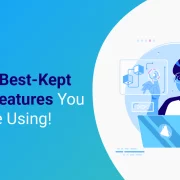
How Data Analytics Can Benefit Career Development and Maximize Student Success?
Summary
This blog discusses how data analytics in education provides personalized career guidance by analyzing academic performance, skills, interests, and employment trends, highlighting benefits like customized learning and timely interventions.
Educational data analytics can provide helpful insights into student performance, engagement, and career development. Three out of five organizations are using data analytics to spur corporate innovation. By analyzing data like grades, attendance, and online activity, you can identify which students are doing well and which may need further support.
Further, it is important to map students’ career pathways and identify their potential for different courses and trajectories.
Table of Contents:
- What are the Benefits of Using Data Analytics for Career Development?
- Why is Data Analytics Important for Student Career Development?
- Summing Up
What are the Benefits of Using Data Analytics for Career Development?
1. Proactive Approach
It allows for a more proactive approach to education where you can intervene before a student falls far behind. Further, it helps understand the characteristics of successful students, which can then be encouraged.
2. Customized Learning
You can understand each student’s strengths and weaknesses through academic performance analytics and create personalized learning plans. This can improve student engagement and retention as the learning caters to a student’s learning style and goals.
3. Timely Intervention
Intervention strategies play an important role in keeping students on track. Educational data analysis enables timely interventions as you can spot warning signs like falling grades or reduced attendance and participation. Early interventions in the form of tutoring or counseling can help students overcome obstacles.
Also Read: 10 Best Online Teaching Platforms to Start Your Teaching Career
4. Student Engagement
Measuring student engagement is critical for understanding how effective a course is. As remote learning becomes more prevalent, ensuring that students are engaged becomes all the more important.
Data analytics can help measure student engagement in different forms, such as participation in discussions, submission of assignments, and engagement with course materials.
By analyzing this, you can gauge which aspects of a course are most engaging and which need to improve. You can also adjust teaching strategies for better engagement outcomes.
5. Student Retention
Data can help predict risks to student retention or academic difficulties. This helps identify potential obstacles at an early stage before they worsen. Early warning signs could include data relating to attendance, grades, and course engagement.
It can also help forecast student retention by analyzing historical data to come up with effective student retention strategies.
6. Graduate Pathways
Data analytics tools can enable educators to devise personalized course recommendations and career pathways, supporting students in their academic and career trajectories.
It can help students evaluate different career options and make an informed decision. For instance, it can assess labor market trends and the success rates of alumni in various fields. Using predictive analytics for student outcomes, educators can advise students on which courses and skills are most likely to result in employment.
7. Alumni Progress
By tracking the progress of alumni, you can gain useful insights into the results of different career pathways. You can maintain a centralized alumni information database containing alumni contact data and their academic journey and achievements.
Data analysis in education can help understand the career outcomes of different courses. This can help you guide students in their career development. It can also provide useful information for curriculum design as you understand which skills and capabilities are important to teach.
8. Improving Course Offerings
Universities can improve their course offerings by identifying courses that are in high demand and those that are not engaging to students and need to be improved. Enrollment patterns, student demographics, and course evaluations can help universities assess which courses to offer and when.
They can also redesign courses to make them more effective. In this way, data-driven decision-making in education can lead to more streamlined courses.
9. Improving Teaching Effectiveness
Data analytic tools can provide helpful insights into student learning outcomes. This helps instructors understand how effective their teaching is and how students engage with the course. In this way, faculty can identify where they can improve and which teaching strategies are working best.
10. Internships and Job Placements
Data-driven platforms can match students with internships and job opportunities based on their skills and career interests. It can analyze data on successful placements and employer requirements.
Why is Data Analytics Important for Student Career Development?
Data analytics plays an increasingly pivotal role in student career development as it provides critical insights that help plan educational and professional pathways.
1. More Effective Guidance
In an increasingly complex and uncertain job market, traditional career pathways fall short and are unable to meet each student’s nuanced and personal needs. Data analytics helps bridge this gap and enhance the effectiveness of career guidance.
One major benefit is its ability to deliver personalized guidance. Data analytics tools can customize recommendations by analyzing students’ academic performance, skills, and interests.
This improves the chance that students will make informed and satisfying career choices. Predictive analytics can also show the growth potential of a particular career option, such as emerging fields in technology and healthcare.
2. Identify Employment Trends
Analytics can help students and universities understand labor market trends and skills that are in demand. Through employment data and alumni information, students can gain real insights into the pathways of particular courses. This enables students to make strategic decisions, ensuring they are prepared for the job market.
3. Placement Programs and Internships
Internship and job placement programs can improve by analyzing patterns in successful placements. Further, feedback and outcome data on internships or placements can contribute to improving career guidance programs.
It can also help placement programs match students with opportunities based on their unique profile, interests, and achievements.
4. Identify Student Strengths
Data analytics can enhance student’s self-awareness by providing insights into their strengths and weaknesses to help them determine which career they are well-suited to. Tools that analyze academic performance, and extracurricular activities, and conduct personality assessments can help identify student strengths and career inclinations.
Also Read: 13 Ways eLearning Platforms Can Help You Achieve Your Career Goals
Summing Up
Data analytics in education can help improve student outcomes, particularly in the field of career development. It encourages a more personalized and proactive approach and offers valuable insights for students and educators that help identify career trajectories.
Hurix Digital offers course development services and assessment solutions for K12 schools and universities to help educators craft a custom learning experience.
Schedule a call to find out more!

Currently serving as the Vice President of Technology Delivery Operations at HurixDigital, a prominent global provider of digital content and technology solutions for publishers, corporations, and educational institutions. With over 16 years of experience spanning EdTech and various domains, I hold certification as a SCRUM Product Owner (CSPO). My expertise includes operations, finance, and adept people management skills.






